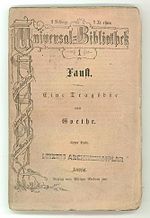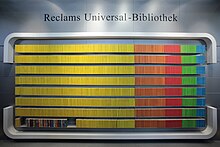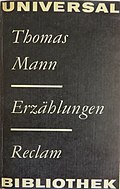Reclams Universal Library
The books in the universal library of the Reclam publishing house are known as Reclam books . German and international literature is offered at a reasonable price and is used particularly in school and university education. The book series was founded in 1867, making it the oldest on the German market. Around 600 million copies had been sold by 2017.
history
Start of the Universal book edition

The reason for the foundation of the series was a law of the German Confederation that came into force on November 9, 1867 , through which all literary works whose authors died 30 or more years ago became public domain . Therefore, the authors did not have to pay any remuneration, nor did they have to buy usage rights from another publisher. This eliminated a major cost item in the publication of books. In addition, Cotta-Verlag's monopoly on works by German classics expired .
The publication of the universal library by the Philipp Reclam jun. in Leipzig began on November 10, 1867 with the first two numbers: Faust I and Faust II by Goethe . The first production, which was very large for the publishing house at the time, with 5,000 copies each of the two Faust editions, was as good as sold out within a few weeks, so that in December 1867 another 5,000 and in February 1868 an additional 10,000 copies were printed and delivered. By the end of 1867, another 33 numbers were published in the Universal Library, including works that are less well-known today such as "Der Kaliber" by Adolf Müllner and August von Kotzebue's comedy The Roebuck.
The price (2 silver groschen per volume), which was low from the start , was maintained for 50 years.
In addition to classical and soon also modern literature, scientific , legal (legal texts) and philosophical works as well as opera libretti were in the program.
After the introduction of the mark as currency in the empire , the price was 20 pfennigs. By April 1898, 3810 volumes had already appeared, many of which, however, only had one edition.
From 1912 onwards, in addition to over-the-counter sales, there were also so-called machine books to promote sales , which could be purchased from up to 2000 (as of 1917) vending machines, especially at train stations, as travel reading and “every friend of good books can enjoy rich reading while traveling and for Convey hours of fleeting conversation conveniently and cheaply, ” as the blurb suggested.
Around 1918 (at least) 40 booklets appeared under the deviating series title Reclam's entertainment library as (also small-format) hardcover, which, however, are listed by the DNB as a “universal library”; the booklets probably appeared in both cover versions at times.
During the National Socialist era, works by Jewish and politically undesirable authors were removed from the Universal Library.
In 1947 the publishing house was separated into an east and a west branch (until after reunification in 1992). At that time there were two rows: one based in Leipzig and one based in Stuttgart .
Cultural history
The Reclam booklet has long been part of the educational system in German-speaking areas. The simple presentation means that the volumes are not as durable as bound books; As a rule, they are not given bibliophilic value. In times of crisis and war, inferior types of paper were used ("war paper", see wood pulp ), which enabled the low price to be kept. In this respect, the Reclam booklets were more suited to short-term reading needs, especially in the periods mentioned, but not to the development of a permanent library.
Until 1960, it was German classics that achieved the highest editions: Schiller's Wilhelm Tell (5 million), Lessing's Nathan the Wise (2 million) and Goethe's Hermann and Dorothea (2 million).
In 2017 the series contained around 3500 available titles.
The Reclam Art Guide series is also named in the volumes as part of the Universal Library.
Book museum
In 2018, the Reclam Museum was opened in Leipzig opposite the former headquarters of the publishing house , which houses the most comprehensive collection of editions of the Reclams Universal Library.
Cover design
General
The covers of the universal library were and are designed uniformly at longer intervals, with the design being revised several times (first in 1917 and 1936). The dimensions have also gradually increased.
Issues 1867 to 1945
The first editions were really artistically decorated and both the cover and the inside of the text were made entirely in Fraktur . Among other things, a looped tape on the left of the front indicated that “Any number can be bought anywhere for 20 pfennigs”. This can be described as Type 1 of the University Library. - Type 2 was followed by a twisted Fraktur script (for Reclam's Universal Library ) on the top, surrounded by simple rectangular ornaments; see picture series.
The dimensions of the booklet have increased from initially 10 × 15.8 cm ( Type 1 and Type 2 ) to 10.3 × 18.5 cm ( Type 3 ) to 11 × 18 cm ( Type 4 ).
The aforementioned vending machine books , which remained episodes, were pink in the first phase of sales. Later, in the context of price increases, a separate design (wallpaper pattern) was developed for the machine books. Complete books from the University Library were taken over if they did not exceed a certain number of pages, or excerpts from books from the University Library were compiled into a volume of fewer pages. This was often used in short stories and poems.
Stuttgart edition (1945–1990)
In 1949, 1957, 1970, and 1988 the design was fundamentally revised. In 1949, the publisher said goodbye to Fraktur , and Garamond was used instead . The envelopes changed from light brown to yellow in 1970. While until 1988 a blurb was completely missing or in the past only consisted of advertising by the publisher, since then the cover has been printed with brief information on the work (back) and a vignette (front) that matches the work.
Leipzig edition in the GDR (1945–1990)
After the publishing house separated in 1947, different paths were also taken when it came to questions of design. The design from 1936 was initially only carefully changed for the Leipzig edition. In addition to the author, the title and the publisher, graphic elements were still to be found on the covers; In 1957 the font was changed. The Leipzig publishing house management continued the earlier pricing policy insofar as the little books cost between 2 and 2.50 marks , depending on the number of pages.
In 1963 the appearance was fundamentally revised; on the front there was only writing and on the back information about the author and work, classified as type 3 . The front cover read UNIVERSAL (above) and LIBRARY (below) in capital letters, with the name of the author and the title in italics in serifs in between. (see upper row of pictures under Stuttgart edition )
The new cover design was based on a design by Irmgard Horlbeck-Kappler . In addition, the book format has been enlarged. The last adjustment was made in the 1980s. In contrast to the West German edition, the volumes were monochrome (beige or black); the lettering Universalbibliothek was initially colored differently depending on the genre. However, the color coding was soon abandoned.
Development 1990–2012
The Leipzig edition design disappeared from the market and the design of the Stuttgart edition was retained. The last revision of the envelopes took place in 2012.
In addition to the paperback booklets, the publications were also available as solidly bound books in full linen until about 1900 (richly decorated calico with golden title vignette, gold-embossed title on the spine and marbled headcut, later bookbinding linen , from about 1920 in blue volumes without gold decoration) and in Magnificent volumes made of embossed full leather available.
Color scheme since 2012

Within the universal library, the booklets are set off by a color code , with the word universal library now appearing on the back of the cover:
- Yellow: Monolingual editions in German, mostly with notes and a foreword or afterword. This series also includes overview works, for example on German literature, history or philosophy.
- Red: Foreign language editions with vocabulary assistance.
- Orange: Bilingual editions ( source language / German).
- Blue: Reading keys and working texts for the lesson, for example short stories for a specific year.
- Green: explanations, interpretations , source texts .
- Magenta: non-fiction books on history, society, art, music, nature, politics or religion.
literature
- Georg Witkowski : People and Book . In: Reclams Universum 41 (1924.2), pp. 196-198.
- Annemarie Meiner: Reclam. A history of the Universal Library on its 75th anniversary. Philipp Reclam jun., Leipzig 1942.
- Reclam. 100 years of the universal library. 1867-1967. Philipp Reclam jun., Stuttgart 1967.
- Dietrich Bode: Reclam. 125 years of the universal library. 1867-1992. Publishing and cultural history articles. Philipp Reclam jun., Stuttgart 1992, ISBN 3-15-010378-9 .
- Frank Wagner: "Sitting tightly in the armchair last day ...". The success story of Anton Philipp Reclam and his "Universal Library". In: Leipzig 1896. Snapshots of a book trade town (= Leipziger Hefte 8). Sax-Verlag, Beucha 1996, pp. 19-33, ISBN 3-930076-39-X .
- Complete bibliography up to 1945:
- Hans-Jochen Marquardt : Reclam's universal library. Complete directory by volume numbers 1867 to 1945 . Reclam, Stuttgart 2018, ISBN 978-3-15-950526-8 .
- Bibliography of the Stuttgart series:
- Dieter Meier: Reclams Universal Library, Stuttgart 1947–1992: A bibliography. Philipp Reclam jun., Stuttgart 1992, ISBN 3-15-010379-7 .
- Bibliography of the Leipzig series:
- Udo Braun, Lothar Kretschmar: Reclam's Universal Library: Complete Directory 1945–1963. Reclam, Leipzig 1969.
- Reclam's Universal Library: Complete Directory 1963–1975. Reclam, Leipzig 1978.
- Hans-Jochen Marquardt : 150 years of Reclam's Universal Library. A reminder of the legal requirements for its foundation and its development up to 1945 . In: Leipziger Almanach 2015/16. Information, calendars, articles , City of Leipzig, the Lord Mayor, City Archives Leipzig (ed.). Leipziger Universitätsverlag, Leipzig 2017, ISBN 978-3-96023-178-3 , pp. [83] -118.
Web links
- Bibliographical references from the Library Service Center (BSZ) Baden-Württemberg / Southwest German Library Association
- Book history using volume 121 as an example
- Web presence of the publisher
- List of the volumes already published up to 1898 (PDF; 1.49 MB)
- Volumes from Reclam's Universal Library in the German National Library
See also
Individual evidence
- ↑ a b c Deutsche Welle (www.dw.com): Reclam's yellow series: 150 years of world literature for everyone. November 10, 2017. Retrieved November 20, 2017 .
- ↑ a b Rainer Moritz 'celebratory speech on 150 years of Reclam's Universal Library / "Small, very personal eulogy for Reclam Verlag". In: Börsenblatt. November 13, 2017. Retrieved November 20, 2017 .
- ↑ a b Ernst Johann / Jörg Junker: Illustrated German cultural history of the last hundred years, Munich 1970, p. 239.
- ↑ According to the advertisement listed on the front and back end of it in a booklet by Balzac, Drei Erzählungen aus Die Menschen Komödie , Leipzig undated (1918), DNB gives for the softcover “No. 1895 / 1896a ”, the HC version has no numbers.
- ^ A b Karl-Heinz Fallbacher: The world in yellow , on the redesign of the publishing program, Reclam 2012 (PDF; 2.8 MB).
- ↑ In the imprint of the GDR editions of the 1970s there is a serial draft: Irmgard Horlbeck-Kappler , for example in Seume .
- ↑ English, French, Italian, Latin, Russian or Spanish.








